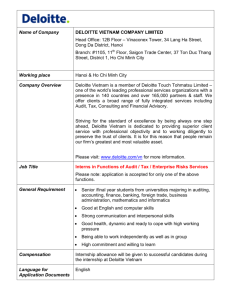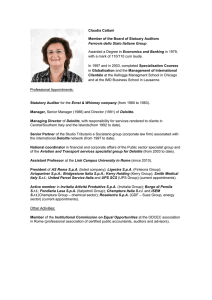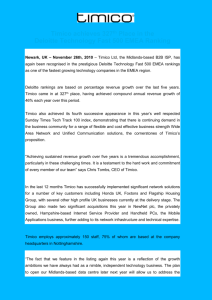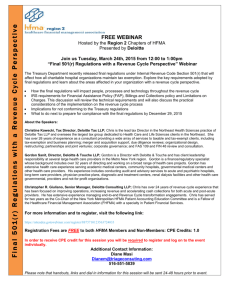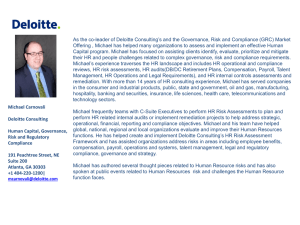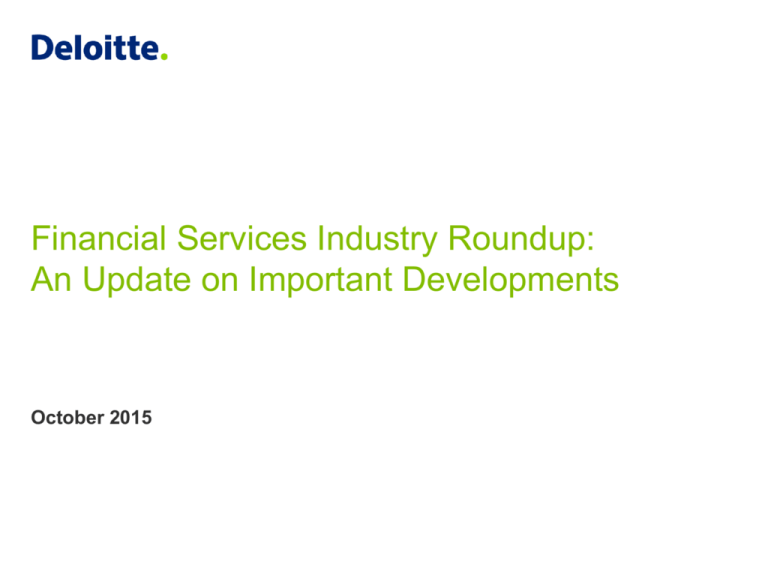
Financial Services Industry Roundup:
An Update on Important Developments
October 2015
Agenda
•
Incurred vs. Expected Update: Accounting for Financial
Instruments – Credit Impairment
•
Refresher: Troubled-debt Restructurings
•
Update: Financial Institutions Hot Topics
•
Update: General U.S. GAAP (including revenue update)
Copyright © 2015 Deloitte Development LLC. All rights reserved.
Keep in mind
This presentation does not provide official Deloitte &
Touche LLP interpretive accounting guidance
Check with a qualified advisor before taking any action
Copyright © 2015 Deloitte Development LLC. All rights reserved.
Incurred vs. Expected Update:
Financial Instruments – Credit
Losses (Subtopic ASC 825-15)
Accounting for Financial Instruments – Credit Impairment
• Project objective and background:
– Expected model (proposed) vs. Incurred model (current)
– Under the current U.S. GAAP incurred loss model, an entity does not record
an impairment loss until it is probable that the asset is impaired or if there has
been a triggering event for an incurred loss.
– In December 2012, FASB launched the Financial Instruments – Credit Losses
(Subtopic 825-15) accounting standard update initiative related to the Current
Expected Credit Losses (“CECL”) model.
– First began as a joint-project between FASB and IASB; however, concerns
over the initially proposed “three-bucket model” resulted in the FASB
separately developing the CECL model while the IASB moved forward with
the “three-bucket model”.
– The goal is to develop a single credit loss model for financial assets that
enables more timely recognition of credit losses and to therefore benefit
financial statement users.
– Latest update was May 2015.
Copyright © 2015 Deloitte Development LLC. All rights reserved.
Accounting for Financial Instruments – Credit Impairment
• Where are we? Summary of key tentative decisions:
• Forward-looking analysis: Current GAAP guidance requires the use of
past and present events, but the CECL model would require an institution
to utilize future information and supportable forecasts to estimate the
allowance and disclose the factors that influence its estimate.
• Removal of “probable” threshold: Currently, an entity is not required to
record a loss until a loss on the asset is deemed to be “probable and
estimable.” CECL requires that an entity forego the worst-case or bestcase scenario and instead evaluate the possibility that a loss exists or that
it does not. This would result in losses being recognized sooner.
• Loss horizon changes: The incurred loss model estimates losses for
loans likely to default in the next 12 months, while the new guidance
requires an institution to estimate losses over the lifetime of the loan for all
loans
Copyright © 2015 Deloitte Development LLC. All rights reserved.
Accounting for Financial Instruments – Credit Impairment
• Where are we? Summary of key tentative decisions (cont):
• “Time and Money”: Under the proposed guidance, estimates must take
into account the time value of money explicitly or implicitly.
• Redefinition of a collateral-dependent asset: The proposed guidance
defines a collateral-dependent asset as “a financial asset for which the
repayment is expected to be provided primarily or substantially through the
operation (by the lender) or sale of the collateral,” broadening its definition
from “solely” to “primarily or substantially” and clarifying that operation
should only be considered if it is operated by the lender as opposed to the
borrower.
• Frequency: Under the CECL model, expected credit losses would be reestimated every reporting period. Favorable and unfavorable changes
would be reported in earnings.
• AFS Debt Securities: Excluded from the scope of CECL and would
continue to be assessed for impairment under ASC 320.
Copyright © 2015 Deloitte Development LLC. All rights reserved.
Accounting for Financial Instruments – Credit Impairment
• Effects of CECL on allowance levels:
• Higher allowance: Allowance levels as a whole would likely rise with the
implementation of FASB’s latest proposal. Most of the increase could be
attributed to the fact that an entity would now need to utilize future
forecasts to estimate losses and that it would need to utilize an estimate of
“lifetime of loan” losses. This new methodology would cause an increase in
reserve levels, particularly for the non-impaired portfolio (current FAS 5
[ASC 450-20]).
• Day 1 view: The change that would require an entity to now hold a day
one allowance for purchased credit impaired assets would also cause a
rise in allowance levels, although it would have a net-neutral effect on
earnings as the increase in reserves would also be added to the amortized
cost of the loans.
Copyright © 2015 Deloitte Development LLC. All rights reserved.
Accounting for Financial Instruments – Credit Impairment
• Effects of CECL on allowance levels (cont):
• Economic downturns: An entity would likely recognize losses earlier at
the beginning of a downturn, so its provision level would increase during
this point in the economic cycle. Then, during the downturn, there would
most likely be a smaller provision since these losses would have already
been recognized. Finally, there would be a higher provision coming out of
the downturn rather than the allowance release typical under the current
model.
• Lower volatility: In theory, the CECL model could provide for less volatility
in the allowance. Some observers have pointed out, however, that the
model could in fact cause higher volatility, particularly because of the
difficulties around trying to estimate the impact of future events.
Copyright © 2015 Deloitte Development LLC. All rights reserved.
Accounting for Financial Instruments – Credit Impairment
• Next Steps:
• An effective date for the final guidance has not yet been proposed but will
be determined at a future FASB meeting.
• Earlier in 2015, the FASB directed its staff to prepare a draft of the final
ASU for distribution to stakeholders (including financial statement users,
preparers, and auditors) to obtain feedback on the proposed amendments
(“fatal flaw review”).
• In other words, we are getting closer, but still working through final stages.
• Helpful Handouts:
• Deloitte Heads Up – March 13, 2015 – FASB Finalizing Credit Impairment
Guidance (includes key points on scope, recognition, measurement, unit of
account, practical expedients, and helpful appendices).
• Accounting for Financial Instruments: Impairment – Tentative Board
Decisions to Date During Redeliberations (through May 20, 2015)
Copyright © 2015 Deloitte Development LLC. All rights reserved.
Refresher:
Troubled-debt Restructuring
(“TDR”) (Subtopics ASC 310-40,
ASC 470-60)
Troubled-debt Restructuring (“TDR”) – Refresher
• Key points of ASC 310-40 and ASC 470-60:
– Definition: A TDR has occurred if the creditor for economic or legal reasons,
related to the debtor's financial difficulties, grants a concession to the debtor
that it would not otherwise consider.
– Criteria: Following factors must both be present:
• The borrower is experiencing financial difficulty (factors listed in ASC 47060-55-8).
• The lender has granted a concession (factors listed in ASC 310-40-15-9)
– Impaired Loan: A loan restructured in a TDR is an impaired loan. For these
loans, the contractual terms of the loan agreement refer to the terms specified
by the original agreement, not the restructured agreement.
– Measurement: A creditor measures impairment based on the present value
of expected future cash flows discounted at the loan's effective interest rate,
except that as a practical expedient, a creditor may measure impairment
based on a loan's observable market price, or the fair value of the collateral if
the loan is a collateral-dependent loan.
Copyright © 2015 Deloitte Development LLC. All rights reserved.
Troubled-debt Restructuring (“TDR”) – Refresher
• Key points of ASC 310-40 and ASC 470-60 (cont):
– Measurement (cont): If the present value of expected future cash flows (or,
alternatively, the observable market price of the loan or the fair value of the
collateral) is less than the recorded investment in the loan, a creditor shall
recognize an impairment by creating a valuation allowance with a
corresponding charge to bad-debt expense or by adjusting an existing
valuation allowance for the impaired loan with a corresponding charge or
credit to bad-debt expense.
– Measurement (cont): Regardless of the measurement method, a creditor
shall measure impairment based on the fair value of the collateral when the
creditor determines that foreclosure is probable.
– Relation to current impairment model: If a creditor concludes that an
individual loan is impaired, the creditor shall not establish an allowance in
addition to one measured under ASC 310-10 (formerly FAS 114).
Copyright © 2015 Deloitte Development LLC. All rights reserved.
Troubled-debt Restructuring (“TDR”) – Refresher
• Impact of proposed CECL model:
– Cost basis: The guidance regarding the cost basis adjustment for TDRs will
be clarified to require an entity to increase the cost basis of the restructured
financial asset through a corresponding increase in the entity’s allowance for
expected credit losses in certain TDRs.
– Prepayments: An entity may consider prepayment expectations and
prospectively reflect an adjusted yield if prepayment speeds are different than
expected. (This decision is contingent on the Board’s review of staff prepared
examples illustrating this approach.)
Copyright © 2015 Deloitte Development LLC. All rights reserved.
Update:
Financial Institutions Hot Topics
Financial Institutions – Hot Topics
• Megatrends that will change financial services as driven by
“clusters of innovation”:
– Primary accounts: Customer preferences are changing thanks to advances
in the digital economy. As a result, primary account providers will change as
well, including the following examples:
• Fully virtual: Virtual channels will expand beyond basic transactions to provide
broader functionality such as onboarding and servicing.
• Customer driven: As customers become more tech savvy, they’ll wield greater
influence on the value propositions and customer experiences that financial
institutions bring.
• Seamless: Banks will need to cater to heightened expectations of customers who
are accustomed to the seamless customer experience offered by technology
providers.
• Customized: Service offerings will evolve to target and meet the needs of each
segment or community, moving away from a one-size-fits-all mass market
approach.
• Externalized: Financial institutions will rely more on external providers to deliver
online and mobile solutions in a timely manner.
Copyright © 2015 Deloitte Development LLC. All rights reserved.
Financial Institutions – Hot Topics
• Megatrends that will change financial services as driven by
“clusters of innovation” (cont):
– Payments: Mobility and connectivity are coming together to make the longanticipated cashless society a reality, including the following examples:
• Cashless: More customers will choose payment cards over cash, even for small
transactions.
• Concealed: Payment processes will be concealed from end customers, changing
their needs and behaviors.
• Connected: Transactions will become a more important customer touchpoint for
merchants and financial institutions.
• Data driven: With the data flow from payment transactions, financial institutions,
services providers, and merchants will gain a greater understanding of customers
and businesses.
• Economical: Electronic transactions will become cheaper as new solutions
proliferate.
Copyright © 2015 Deloitte Development LLC. All rights reserved.
Financial Institutions – Hot Topics
• Megatrends that will change financial services as driven by
“clusters of innovation” (cont):
– Capital markets: Future of capital markets to be greatly impacted by
‘distributed capital raising platforms’, otherwise known as websites that help
businesses and investors help find each other:
• Accessible: More businesses and projects will get in front of each other.
• Controllable: Individual investors will gain more control over investment decisions.
• Efficient: As businesses are tested through capital raising process, investments will
flow to most promising opportunities.
• Flexible: Businesses will be better able to structure funding instruments to meet
their needs better and appeal to more investors.
• Economical: As intermediaries decline, so will the cost of investment to individual
investors.
• Handout:
• Deloitte FSI Publication – Five megatrends that will change financial
services
Copyright © 2015 Deloitte Development LLC. All rights reserved.
Update:
General U.S. GAAP
FASB standard-setting activities
Major projects
Expected date*
2015
Q1-Q2
2016
Q3-Q4
Leases
X
Financial Instruments: Classification & Measurement
X
Financial Instruments: Impairment (previously discussed)
X
Financial Instruments: Hedging
New Revenue Standard
Q1-Q2
TBD
Deferred to FY18 or FY19
Other ongoing projects to be aware of:
• Clarifying the definition of a business
• Liabilities and equity – short-term improvements
*Chart indicates Deloitte’s expected timing
Copyright © 2015 Deloitte Development LLC. All rights reserved.
Leases project
• Boards primarily converged with the lessor model but are diverged with lessee
model
• Items recently discussed:
Lessor Model
– Incorporating collectibility into the model
– Accounting for a Type A lease modification
– Impairment of lessor Type A lease assets
Lessee Model
– Accounting for the purchase of a leased asset
Copyright © 2015 Deloitte Development LLC. All rights reserved.
Leases project
•
Items remaining to be redeliberated:
– Effective date
– Sweep issues
– Other consequential amendments
• Final standards likely to be issued late in 2015
Copyright © 2015 Deloitte Development LLC. All rights reserved.
Financial instruments project
• Classification & measurement
– Final Standard – Expected in 2nd Half of 2015
• Hedge accounting – FASB considering:
– Hedge qualification and documentation requirements
– Hedge effectiveness testing
– Presentation of ineffectiveness
– Disclosures
Copyright © 2015 Deloitte Development LLC. All rights reserved.
New revenue standard deferral
FASB ED on deferral of effective date by 1 year
• Public companies – Reporting periods beginning after December 15, 2017 (FY
2018)
• Nonpublic companies – option to defer additional year
• Comment period ended
• 64 comment letters received
Copyright © 2015 Deloitte Development LLC. All rights reserved.
New revenue standard – key items
Identifying performance obligations
• Immaterial promised goods or services
− May disregard when immaterial in the context of the contract
• Shipping and handling
− Practical expedient to allow shipping and handling that occurs after control
has passed to the customer to be treated as a fulfillment cost (rather than as
a revenue element)
• Clarify the meaning of a promise that is separately identifiable
Refine the term “separately identifiable”
Reframe the separation criteria to focus on a bundle of goods or services,
and
Add examples to the standard’s implementation guide
Copyright © 2015 Deloitte Development LLC. All rights reserved.
New revenue standard – key items
Licensing
• Determining the nature of an entity’s promise in granting a license
− Functional IP – right to use IP (point in time recognition)
− Symbolic IP – right to access IP (over time recognition)
• Sales-based and usage-based royalties
− Only apply constraint when the royalty only pertains to license of IP, or
license of IP is the predominant feature
− Guidance does not support splitting royalties
Copyright © 2015 Deloitte Development LLC. All rights reserved.
Revenue – principal versus agent
Tentative decisions
• Background: On August 31, 2015, the FASB issued a proposed ASU to
address issues raised regarding how an entity should assess whether it is the
principal or the agent in contracts that include three or more parties.
• Control Considerations: The proposed ASU would add clarifying guidance on
the types of goods or services that a principal may control. In addition, the
proposed ASU would reframe the indicators in the new revenue standard to
illustrate, including primary obligor, inventory risk, ability to establish pricing, and
credit risk.
• Next Steps: Comments on proposed ASU are due by October 15, 2015.
Copyright © 2015 Deloitte Development LLC. All rights reserved.
FASB simplification initiative
Final standards
• Extraordinary and Unusual Items (ASU 2015-01)
• Presentation of Debt Issuance Costs (ASU 2015-03)
• Measurement Date of Defined Benefit Pension Plan Assets (ASU 2015-04)
• Accounting for Cloud Computing Costs (ASU 2015-05)
Other projects
• Subsequent Measurement of Inventory
• Accounting for Income Taxes
• Employee Share-Based Payment Accounting Improvements
• Accounting for Measurement-period Adjustments in a Business Combination
• Simplifying the Equity Method of Accounting
• Balance Sheet Classification of Debt
Copyright © 2015 Deloitte Development LLC. All rights reserved.
This presentation contains general information only and Deloitte is not, by means of this
presentation, rendering accounting, business, financial, investment, legal, tax, or other
professional advice or services. This presentation is not a substitute for such professional
advice or services, nor should it be used as a basis for any decision or action that may affect
your business. Before making any decision or taking any action that may affect your business,
you should consult a qualified professional advisor. Deloitte shall not be responsible for any
loss sustained by any person who relies on this presentation.
Copyright © 2015 Deloitte Development LLC. All rights reserved.
About Deloitte
Deloitte refers to one or more of Deloitte Touche Tohmatsu Limited, a UK private company limited by guarantee (“DTTL”), its network of member firms, and their related entities.
DTTL and each of its member firms are legally separate and independent entities. DTTL (also referred to as “Deloitte Global”) does not provide services to clients. Please see
www.deloitte.com/about for a detailed description of DTTL and its member firms. Please see www.deloitte.com/us/about for a detailed description of the legal structure of Deloitte
LLP and its subsidiaries. Certain services may not be available to attest clients under the rules and regulations of public accounting.
Copyright © 2015 Deloitte Development LLC. All rights reserved.
36 USC 220506
Member of Deloitte Touche Tohmatsu Limited


